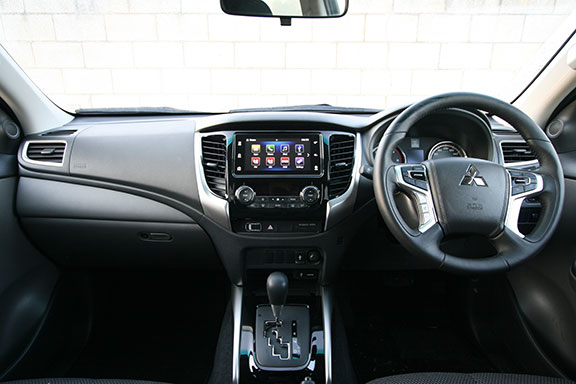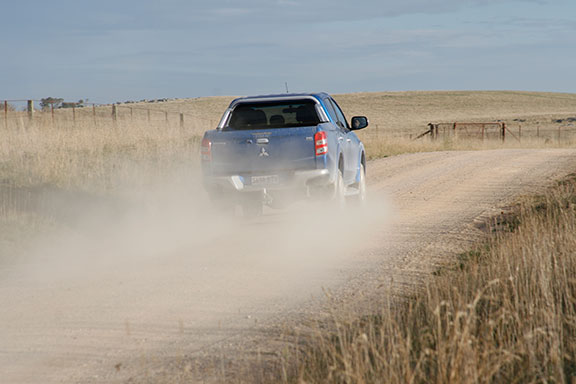Mitsubishi’s Triton may not be as big and brawny as most of its competitors but it also doesn’t come with a big price tag, Fraser Stronach writes
 |
|
The GLS model boasts full-time 4WD
|
In the ultra-competitive and booming 4×4 ute market – dominated by dual cabs – Mitsubishi’s Triton is bettered only in sales by Toyota’s ever-popular Hilux and Ford’s beefy Ranger. That means the Triton outsells Holden Colorado, Nissan’s Navara, Isuzu’s D-Max, Mazda’s BT-50 and VW’s Amarok, and all largely off the back of sharp pricing and on-going factory discounting.
The popular GLS dual-cab 4×4, as tested here, is listed at $41,500, which puts it $10K to $15K cheaper than its immediate competitors. But, as they say in the late-night gadget commercials, that’s not all. For $10 less than that (so $41,490) Mitsubishi will also throw in a free automatic transmission and all on-road costs. For $4K less than that (so $37,490 drive-away, no more to pay) you can get into a GLX+ dual-cab 4×4 automatic. That means if you want a cheaper 4×4 dual-cab then you’ll have to look at a Chinese or Indian offering.
This model Triton (called the MQ and the fifth-generation Triton) arrived in Australia mid-2015 replacing the MN, which debuted in 2009. Compared with the MN, the MQ represented evolution rather than revolution and bought a restyled body, a new 2.4-litre four-cylinder Euro 5-compliant diesel engine, a new six-speed manual gearbox, a revised five-speed automatic (available on all models and not just the Exceed), and various chassis changes.
In designing the MQ Triton, Mitsubishi hasn’t gone down the same line as just about everyone else by building a noticeably bigger ute than the previous generation offering (as did Ford/Mazda in 2011 and Holden/Isuzu in 2012), instead sticking to same basic dimensions as MN or the ML (2006) before that.
 |
|
Unlike many utes the Triton has both tilt and reach steering wheel adjust
|
CLIMB ABOARD
You notice the fact that the Triton is smaller than most of its competitors as soon as you climb aboard. If you want a ute for five big blokes, this isn’t the one, but the Triton’s smaller size and relatively short wheelbase also makes it more manoeuvrable and handy in tight spaces.
Unlike many utes (Ranger and Colorado included) the Triton also has both tilt and reach steering wheel adjust, which helps the driver get more comfortable in a cabin that’s better finished than most and still roomy enough for a four adults or a family with three kids.
ON THE ROAD
The Triton’s smaller size and the fact that all but one of its immediate competitors are heavier also pays dividends on road with relatively nippy handing and good steering response.
Well-sorted suspension too with a decent ride quality even when unladen.
The GLS model as tested here (as well as the more expensive Exceed) also offers a considerable point of difference to all its direct competitors – bar VW’s Amarok – in as much as it’s available with full-time 4WD, rather than the industry standard part-time 4WD. Full-time 4WD means that four-wheel-drive can be used anywhere, including paved roads, and not just off-road as it the case with part-time 4WD. As well as operational convenience, full-time 4WD brings considerable safety benefits, especially on wet bitumen. Other Triton models have conventional part-time 4×4.
In the case of the Triton, full-time 4WD comes via Mitsubishi’s unique ‘Super Select’ system, which also allows the driver to select 2WD for general dry-weather sealed-road driving.
The Triton is also relatively small when it comes to engine capacity – just 2.4 litres – the smallest-capacity engine in any of the popular utes that employs a single turbo. There are smaller capacity engines (in Navara and Amarok) but these have sophisticated bi-turbo systems that help them perform more like bigger capacity engines.
Still, the Triton’s engine does well enough and doesn’t give away much in general performance to its competitors, thanks in part to the Triton being a lighter and smaller ute. It’s still a revvy engine compared with most of its competitors but is still relatively quite and refined and rarely gives the feeling that it is working hard.
 |
|
Being loaded with forklift
|
AT WORK
Eighteen months back we tested the Triton with an 800kg payload in the tub (so pretty well maximum payload when you take account of the driver and a single passenger), and then separately with a 2800kg tow weight hooked up behind. That test was part of a seven-ute payload and tow comparison test and while the Triton wasn’t a star (especially in the payload test) it wasn’t the worst performer.
This time we decided to back off on both payload and tow weight to try to find the Triton’s ‘sweet spot’. With 600kg in the tub (so more like 780kg total payload with driver, passenger and towbar included) the Triton dropped far less at the rear and generally felt better on the road with a more positive steering feeling and less bottoming out of the rear suspension.
As for towing, this time we dropped the tow load to 2500kg and the Triton did well. Certainly the engine performed well with this weight (as it did with 2800kg) and the chassis was also well behaved. Note that the Triton’s legal tow limit is 3100kg, so 400kg short of the best in class.
 |
|
Compared with its competitors the Triton isn’t a frontrunner off road
|
OFF ROAD
Compared with its competitors the Triton isn’t a frontrunner off road. It’s still handy enough as a general-use 4×4 but for hard-core off-roading it’s not up with the likes of Ranger, Hilux and Amarok, the best of the utes in more challenging off-road environments.
OWNERSHIP
The Triton comes with Mitsubishi’s five-year, 100,000km warranty and 15,000km/one-year servicing with fixed prices. For any diesel Triton the 15,000km service will cost $430, the 30,000km service is $530 and the 45,000km service is $550.
As for resale value, used-car value service Red Book has the average resale value at around 60 per cent after three years. Petrol models (only in 4×2) do a little worse at 56 per cent while GLX+ automatic dual-cab 4x4s do best at nearly 63 per cent.
THE BOTTOM LINE
The Triton’s trump card is of course its pricing and there’s no doubt it makes a strong case on value alone provided you don’t need a heavy-duty tow or load ute, or one to carry five big blokes regularly.
Being smaller and lighter also have benefits in terms of manoeuvrability and general handling and then there’s the notable advantage of full-time 4×4 on the models thus equipped.
All up the Triton still does most things and is a more than handy mid-weight load and tow vehicle.
MITSUBISHI TRITON GLS DUAL-CAB SPECS
| Engine: | 2.4-litre 4cyl turbo diesel |
|---|---|
| Max power: | 133kW @ 3500rpm |
| Max torque: | 430Nm @ 2500rpm |
| Gearbox: | five-speed automatic |
| 4WD System: | dual-range full-time (+2WD)* |
| Front suspension: | independent/coil springs |
| Rear suspension: | live axle/leaf springs |
| Tyre/wheel spec: | 245/65R17 |
| Unladen weight: | 1950kg |
| GVM: | 2900kg |
| Payload: | 950kg |
| Towing capacity: | 3100kg |
| GCM: | 5885kg |
| Overall length: | 5280mm |
| Width: | 1875mm |
| Height: | 1780mm |
| Wheelbase: | 3000mm |
| Turning circle: | 11.8m |
| Fuel tank capacity: | 75-litres |
| ADR fuel claim: | 7.6 litres/100km |
| Test fuel use: | 9.5 litres/100km |
| Range: | 740km** |
*See text.
**Based on test fuel use, claimed fuel capacity and a 50km ‘safety’ margin.


